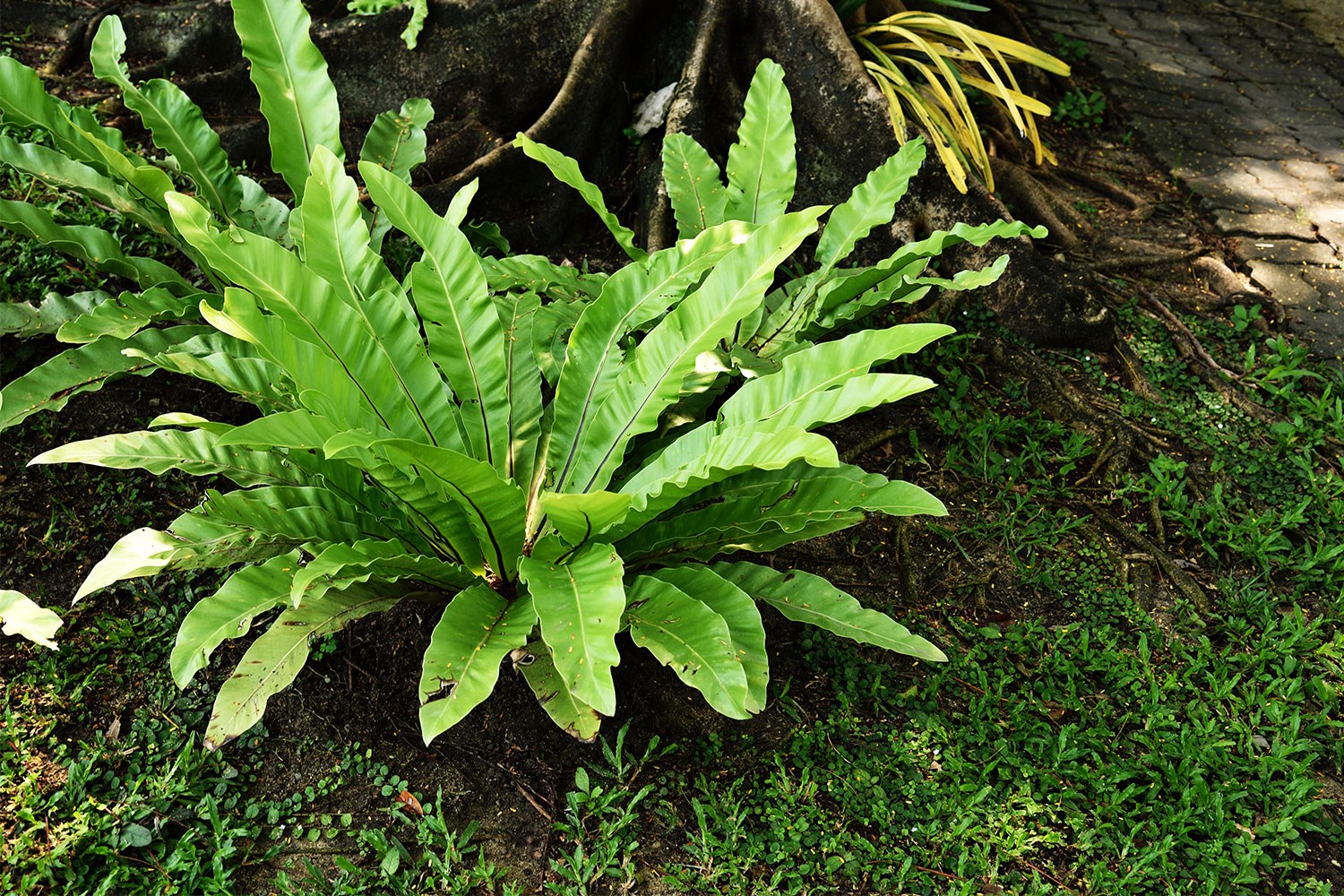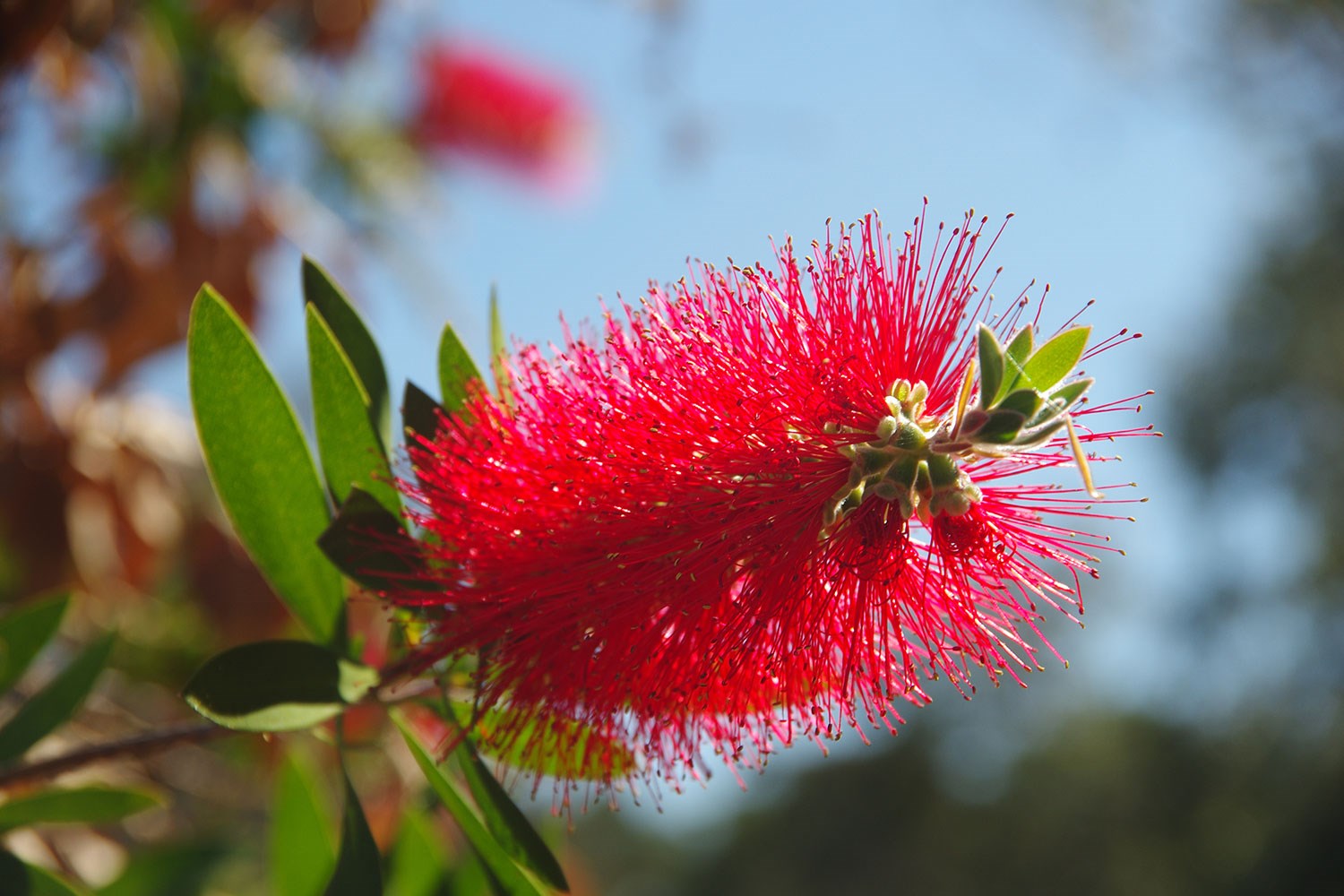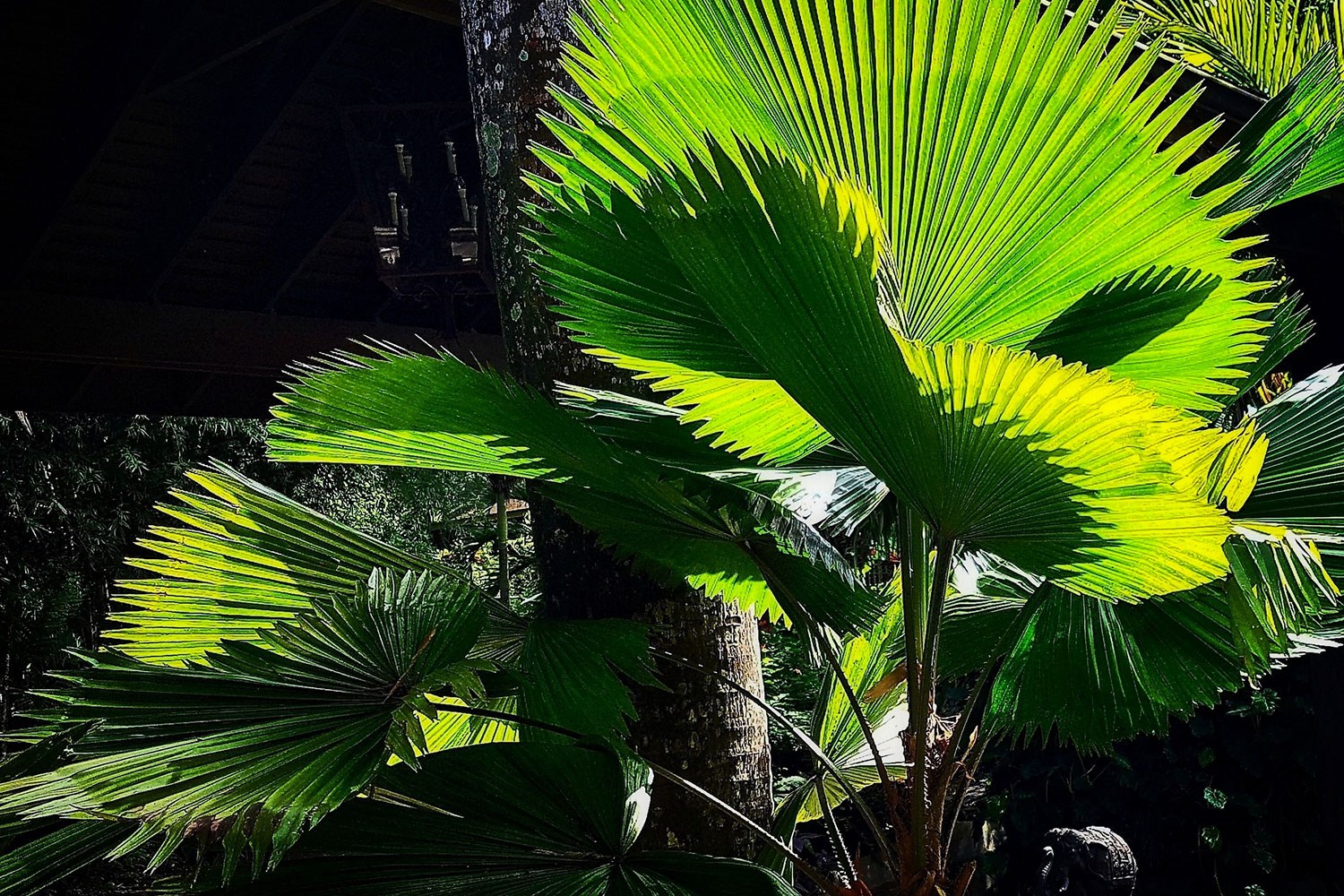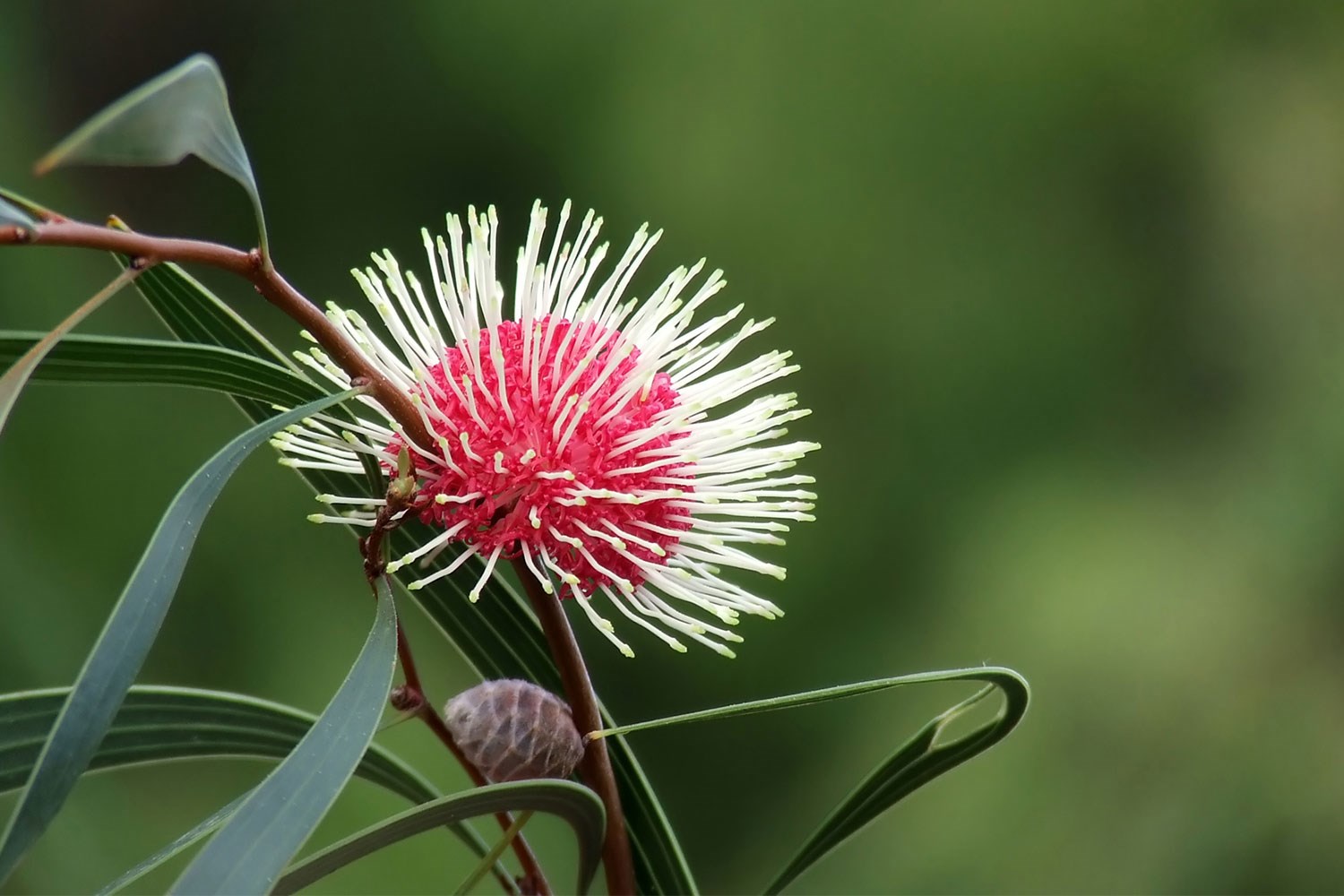Native plants have never been more popular and they can be easily incorporated into any style of garden.
If you want to create an all-Australian native landscape, then an organic, naturalistic design works best.
If you want to create an all-Australian native landscape, then an organic, naturalistic design works best.
“Think crushed granite pathways, timber sleepers for edging beds and rustic recycled containers,” says gardening expert and horticulturalist Roger Fox. “Avoid formality and instead use curved and fluid lines for the layout.”
You can use a variety of grasses, desert plants, shrubs, ground cover, succulents, herbs, food plants, fruit and berries to create a diverse Australian native garden.
If you don’t need a lawn, consider filling deep garden beds with dense plantings of native shrubs and grasses, traversed by winding paths.
“The result will be a very drought-tolerant and wildlife-friendly garden,” says Roger.
Australian native plant selection
You’ll find Australian plants to suit every layer of your garden.
“For flower beds and edgings, think of Australian native flowers such as Swan River daisies and kangaroo-paws with their fabulous velvety flowers,” says Roger.
“For hedges, check out the many varieties of lilly pilly, westringia and callistemon. For shrubberies, look for new forms of the old favourites, like grevilleas, banksias, wax flowers and mint bushes. For striking architectural plants, you can’t go past Gymea lilies and grass trees, with their amazing blackened trunks. And for fabulous low-maintenance tub plants, dwarf acacias like ‘Limelight’ and ‘Green Mist’ are winners.”
There are many stunning Australian native plants to choose from, here is a top 30 list of some of the most popular.
1. Australian daisy (Brachyscome)
Perfect as ground cover, the Swan River daisy (Brachyscome iberidifolia) is one of the most popular Australian native flowers, with delicate mauve, white and blue flowers. Highly adaptable, they grow just about anywhere but prefer well-drained soil in ether full sun or half-sun. Some plants are more drought tolerant and frost tolerant than others.
2. Banksia (Banksias)
Flowering in shades of greenish white, yellow, orange and red, the banksia spans ground covers, low-growing shrubs and low-branching trees. Attracting bees and birds to the garden, banksias need full sun and well-drained, sandy soils. Water regularly after planting but once established they are low maintenance and can withstand dry conditions. Use a controlled release fertiliser formulated for natives.
3. Bird’s nest fern (Asplenium australasicum)
With a leathery rosette of foliage, the bird’s nest fern is easy to grow and can be used to create a rainforest effect in the garden. According to Australian Plants Online, each frond may grow between 1 to 2 metres on mature plants. Bird’s nest ferns prefer a full sun or partly-shaded position. They’re also ideal for growing indoors in a container.
4. Bottlebrush (Callistemon)
A low-maintenance plant, the distinctive vivid red flowers bloom in spring and summer, proving irresistible to bees and birds. A fast growing shrub, bottlebrush prefer well-draining soil and a full sun position.
5. Flame pea (Chorizema)
These evergreen shrubs produce masses of spectacular orange/and or red pea-flowers throughout spring. They grow in light, well-drained soil with full sun or partial shade. They don’t tolerate frequent wet conditions, but benefit from a good soaking in summer.
6. Cycad (Macrozamia)
With dark green palm-like leaves which grow up to one to two metres, these slow-growing plants are ideal for rockeries. They are best grown in well-drained sandy soil. Larger cycads are happiest in full sun, while smaller ones prefer shade. Young plants need regular watering.
7. Elkhorn and staghorn fern (Platycerium)
Relatively easy to grow and low-maintenance, staghorns and elkhorns have distinctive fronds resembling antlers. They have minimal root systems and can grow on tree trunks or attached to a piece of wood. Unlike other plants, the ferns absorb water and nutrients from the air. They prefer warm, humid conditions with light shade and occasional sun.
8. Gum tree (Eucalyptus)
Eucalypts (as well as the new sub-group of Corymbia) are the quintessential Australian native tree. Easily adaptable, they will often grow in very different areas from where they are native. Always choose compact garden-friendly shade plants like the hardy peppermint gum (Eucalyptus nicholii) or the lemon-scented gum (Eucalyptus citriodora).
9. Everlasting daisies (Xerochrysum bracteatum)
Also known as paper daisies, this perennial blooms in late spring to early autumn. A low-maintenance native flower, the colours range from white and pink to deep red, yellow orange, blue and mauve. Create a beautiful meadow effect in the garden by sowing seeds in autumn for spring flowering. Paper daisies prefer sandy soil and full sun.
10. Fan flowers (Scaevola aemula)
This popular shrub grows happily in pots outdoors and features the familiar fan-shaped flowers in white, blue or purple. Most fan flowers need well-drained soil and full sun to thrive.
11. Fan palm (Licuala ramsayi)
A slow growing tree, this palm can grow to 15 metres and features large fan-shaped fronds. They are an excellent shade plant and can also grow in a container indoors. One of the easiest palms to grow, they prefer well-drained fertile soil but can adapt to a variety of soil types.
12. Finger lime (Citrus australasica)
This shrub or small tree grows to 5 metres high and features green cylindrical edible fruits. Very slow growing, finger limes prefer frost-free, richly composted soil. The fruit can be used in a diverse range of food.
13. Grass tree (Xanthorrhoa australis)
A native shrub, the grass tree is an iconic Australian native plant. With distinctive blackened trunks, grass trees sometimes feature towering spear-like spikes up to 5 metres high. The trunk branches out to form long grass-like leaves up to 1 metre or more. Perfect for rockeries, grass trees thrive in well-drained, sunny positions and sandy soil. They are exceptionally hardy but are also slow to grow. Feed with fertilizers for native plants.
14. Grevillea
Grown all over Australia, grevilleas are low-maintenance shrubs that produce abundant flowers. There are over 350 grevillea species and they come in a range of sizes, from ground covers and shrubs to tall trees, which are perfect screening plants. Flowering year-round, the flowers attract bees and birds to the garden. Grevilleas prefer well-drained soils and full sun for best flower production.
15. Hakea
Available in around 150 diverse species, hakea comes in a range of small to medium shrubs. They showcase spectacular flowers and leaves in a variety of colours and shapes. Some Hakeas have long spidery flowers which are similar to grevilleas, while others have prickly leaves and long spears at the end of the branches. Hakeas thrive in full sun with well-draining soil. Keep them looking good with regularly pruning, but keep fertiliser to a minimum.
16. Happy wanderer (Hardenbergia violacea)
Available in three species of climbing shrubs or trailers, these hardy plants feature spearhead-shaped leaves with clusters of small, usually purple pea-flowers. They are highly adaptable in a garden, and can be trained to climb over fences and arbors. The trailing forms are suitable for ground cover. Happy wanderer is best grown in well-drained soil in sun or semi-shade.
17. Illawarra flame tree (Brachychiton acerifolius)
This tall deciduous tree packs a punch in the garden, showcasing red bell-shaped flowers and growing up to 30 metres. It’s often used in Sydney as a companion plant to jacaranda as they flower at the same time in late spring, providing a magnificent display. It’s a low-maintenance plant as long as ample water is available.
18. Kangaroo paw (Anigozanthos)
An iconic Australian native plant, kangaroo paws add texture and sculptural interest to a native Australian garden. The magnificent woolly tubular flowers come in an outstanding colour range of red, yellow, green, orange, pink and near-white. Low on maintenance but high on impact, kangaroo paws prefer slightly acidic soils with good drainage and full sun positions.
19. Kangaroo grass (Themeda australis)
This tussock-forming grass features soft leaves that grow to 30cm. It’s useful as a low-maintenance ground cover and is an ideal choice for rockeries.
20. Lilly pilly (Syzygium smithii)
This medium-sized tree grows to 20 metres, and is a popular choice in the garden for hedging and topiary. Ideal for screening and privacy, it has tiny white fluffy flowers in summer followed by pretty, pink, edible fruits. It’s a hardy and low-maintenance plant that prefers well-composted soils but can cope in most places with adequate moisture.
21. Mat-rush (Lomandra)
A popular grass-like choice for the garden, Lomandra are evergreen perennials with tiny creamy flowers on spikes. An excellent drought-tolerant choice, Lomandra need to be regularly pruned to the ground as dead foliage can build up.
22. NSW Christmas Bush (Ceratopletalum gummiferum)
Growing up to 5 metres high, the NSW Christmas bush is best known for providing gorgeous sprays of red star-shaped flowers in mid-December. A sunny position in the garden ensures plenty of flowers in time for Christmas. It’s low maintenance, preferring soil with good drainage.
23. Pandorea
Perhaps the most popular of all the Australian native climbers and creepers, Pandorea is low-maintenance and hardy. The bower creeper (P.jasminoides) produces glorious trumpet-like flowers from spring to summer in a range of colours from white (‘Lady Di’) to a vivid pink (‘Rosea’). They’re a popular choice for pergolas, archways and trellises. Pandorea prefer moist, well-drained soil in a full sun position. Prune after flowering.
24. Pigface (Carpobrotus)
Best known as a coastal dune plant, this succulent has large spreading mats with yellow to red stems and long three-angled leaves. Easy to grow, pigface is a tough drought-tolerant plant that thrives in all kinds of soil.
25. Sturt’s Desert Pea (Swainsona formosa)
The floral emblem of South Australia, Sturt’s Desert Pea showcases clusters of brilliant red flowers with a black pea-like spot. It can be tricky to grow at home and requires full sun and good drainage.
26. Sydney rock orchid (Dendrobium speciosum)
Blooming in late winter, early spring, Sydney rock orchids provide a spectacular show of mass flowers. A robust plant, it’s drought tolerant and thrives on low-medium humidity with full sun. It’s ideal for growing in well-drained posts with around 25 per cent rocks.
27. Australian tea-tree (Leptospermum laevigatum)
A fast-growing plant, this tall shrub or small tree features deciduous flaky bark. Best known for its lemon-scented leaves and white flowers in spring, it’s an ideal screening plant. Tea trees are best suited to well-drained soil in full sun. Feed it lightly with slow-release fertilizer in spring and prune regularly after flowering.
28. Wattle (Acacia)
A fast-growing tree, wattle produces fragrant yellow flower balls from a young age. Wattles are hardy plants and prefer a sunny spot in the garden with well-drained soil. Keep wattle looking good with light pruning. The Golden Wattle (Acacia pycnantha) is renowned as the national flower of Australia.
29. Waratah (Telopea)
A dramatic plant with fiery red blooms and leathery leaves, waratahs can sometimes be tricky to grow in the garden. They need very well-drained soil or a large container with free-draining potting mix. The floral emblem of NSW, T. specioissima is the most spectacular of its type, but the ‘Corroboree’ and ‘Wirrimbirra White’ varieties have a better chance of thriving.
30. Wax flower (Eriostemon)
These evergreen shrubs showcase waxy pink petals in late winter to spring, providing a pretty display over a long period. Keep them happy in light to medium, well-drained and slightly acid to neutral soil in a sunny, open position. Keep them looking good with light pruning.
Sourced: www.bhg.au





























